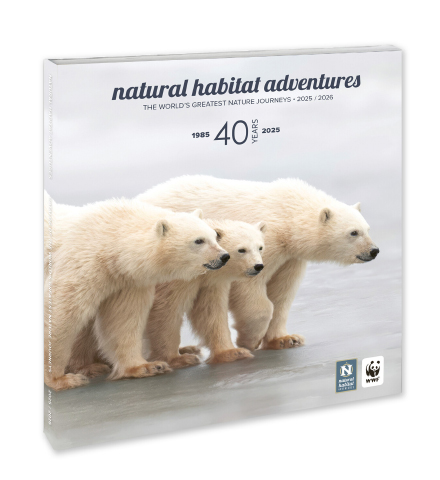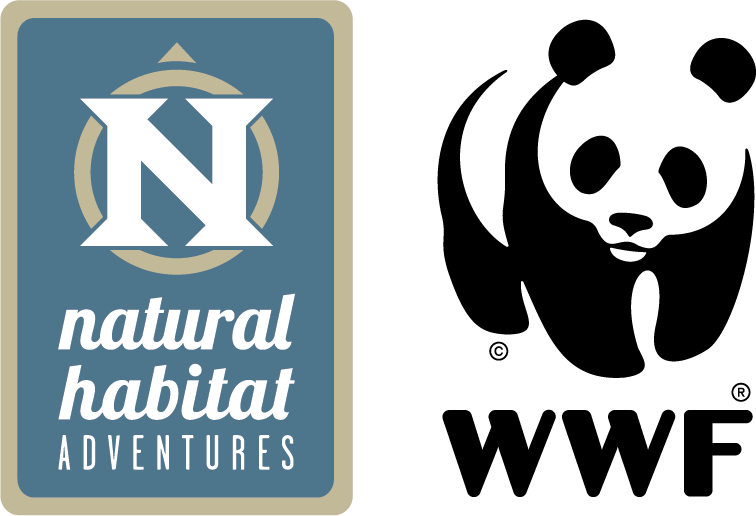By Nat Hab Expedition Leader Kristina Disney
If you’ve ever read the word cacophony in a book but not really understood the meaning, the huskies are happy to teach you. You will always hear them before you see them. Long lonely howls, high-pitched barks, yips, and the sound of claws scratching through ice and snow. And the jumping, I can’t do it justice, but the jumping is part of the sound. Their whole bodies vibrate with energy, and they can’t sit still; they run in circles or jump wildly in the air. Imagine being met with a deafening tidal wave of these sounds every morning as you walk around with a bucket of breakfast that you slosh with a ladle into their bowls under the directed glow of a headlamp. The dogs don’t weaken; the sound doesn’t diminish as days, weeks, or years go by, and they greet you every morning the same way.

Nat Hab guests giving sled dogs some love. Photographed by Expedition Leader © Court Whelan
There is a part of me that stayed in a time and place very far away from the person I am today. That part of me, she’s still there in the one-room cabin next to the dog yard, waking up to embers that hopefully haven’t gone cold in the wood stove. I’d wake up and put on my down slippers to walk around because the floor and the air up to about knee height would be anywhere from 23ºF to 13ºF, depending on how cold it was the night before. Then I’d boil water for oatmeal, which was really just a vessel for a big spoon of peanut butter. I’d get dressed while the kettle boiled and then use the same one bowl and one spoon from yesterday’s oatmeal to eat my peanut butter slurry. Then coveralls, parka, toque, scarf, mitts, boots, and headlamp went on to go feed the dogs their breakfast.

Wapusk Adventures owner Dave Daley and sled dog. Photographed by Nat Hab Expedition Leader © Giulia Ciampini
Most people don’t know this, but when calculating the weight and balance of airplanes, especially small bush planes that fly to remote communities in the Canadian Arctic, Transport Canada’s Standard Weight of Passengers is different for summer and winter. In the summer, male and female passengers are set to an average of 206 and 172 lbs, respectively; in the winter, that weight is increased to 212 lbs and 178 lbs. No, Canadians do not, on average, gain 6 lbs from our Christmas dinners. That is the industry standard for how much heavier our clothes are in the wintertime.
Getting dressed to go outside in the winter is not done in haste; in fact, everything at -22ºF takes longer. You wear layers of mitts, and the dexterity of the task at hand decides how many pairs need to come off to get the job done. My outer pair is made of thick leather mitts with felt liners that my neighbor gave me when I first moved in. They don’t match; one is old and soft, trimmed with beaver fur and has swirling designs on it that some old flame of Larry’s handmade back in the 1980s. The other is rough leather and stiff; the felt is shorter inside, and there is no soft fur or beautiful pattern to trace. This mitt was made as a replacement for the original that Larry left behind on some trapline years ago. I miss Cowboy Larry with his wild stories, but those are not mine to tell. I can say that Larry’s mitts alone, though, weighed more than a pound, so I don’t know where Transport Canada got their lean 6 lbs average from.

Wapusk Adventures owner Dave Daley and his dogs. Photographed by Nat Hab Guest © Susan Topper
As mushers, we revert to the wisdom of our mothers and our mitts are tied to a long string that runs up through one sleeve, across the back and out the other sleeve, tying off the second mitt. The reason being when you’re going down the trail, and your dog’s harness gets tangled with the dog running next to them, or they need the ice cleaned from their paws and a new bootie thrown on, you need to account for every movement you’re going to make because a dog team waits for no one, not even their musher.
First comes the voice command, “Whoa-whoa, that’ll do,” and lightly stepping on the brake mat with one foot while the other balances on the runner like a skier. My hand grabs the ‘parking brake,’ which functions similar to a boat anchor, and before the team has come to a complete stop, I throw it down in the snow to my right, the two-pronged hook digging into the snowpack and the line goes tight, taking the last of the momentum out of the sled and finally the team. There is panting and tail wagging and a few spots of yellow in a previously pristine crystalline bank. I scratch ears and check for chewed lines while I make my way to Goldrush, the two-year-old who kicked off his bootie on his back left paw and needs a new one. Snow is unforgiving after about -4ºF. The humidity is gone from the air, the snowpack sublimates and the top of the banks crust over in a matrix of small sharp crystals that, without the dog booties, will coalesce on the hair between the toes and cut the soft pink skin on Goldrush’s paw.

Musher Wyatt, son of Dave Daley. Photographed by Nat Hab Expedition Leader © Garrett Fache
I throw off my gloves when I get to Goldrush, the strings making sure they dangle at my wrists rather than being left behind or trampled in the snow. I stand over Goldrush, one leg on either side of his ribs, bent over with my face just above his tail and the replacement bootie between my teeth. Checking a dog’s feet is similar to the way a farrier checks a horse’s hooves, and replacing a bootie is like the rodeo event of calf roping, but I realize that those analogies help tell you more about my past than they do paint a picture of what’s about to happen. Just google it; you’ll get a good laugh.

Happy Nat Hab guest dogsledding. Photographed by Expedition Leader © Kristina Disney
The boot is replaced; the whole affair from when I threw down the snow hook has maybe taken two or three minutes at most. Too long, I’m taking too long, the team is telling me. Jennings, in the lead, is starting to dig into the trail; Hippo, beside him, is jumping straight up, verticals so high I think they should have called him Kangaroo instead. The energy of the whole team rises, and the barking and howling begin again. Time to go, time to run is what they are impatiently telling me.
“Eee-asy there,” I say softly back to them all, and I walk back toward the sled. I don’t hurry; I purposefully slow my breathing in an attempt to settle the dogs. In the melee of canid energy, you might think my movements are lost to them, but don’t be fooled. Even at the height of their hysteria, they are still watching me; more aptly, they still feel me. They know by my gait if I’m tired, by my voice if I’m daydreaming or how when I rock the handlebar, I’m impatient cause we are late coming home. They knew the night I was scared when I lost my way across the lake in the blizzard, and they knew how to take me home. Even if we hadn’t spent hours upon hours together on the trail, I suppose they would know because that is just what a dog does.

Nat Hab Expedition Leader © Olga Kolmanic-Piti
Dog sledding has changed so much over the years, from leather lines and bone toggles to aluminum frames and temperature-dependent plastic runners, but the dogs are the same. I’m not talking about the breed, to be clear, though a true huskie will always be a true mutt if you ask enough people who’ve been behind a sled. I mean, their souls are the same. They are beings that are wholly present, and they are truly alive; on a cold, dark night, huskies breathe life back into the winter air and back into you.
These days, I’m a ‘southern,’ and I only make it north for about a month every fall. Like the other Nat Hab Expedition Leaders bound for Churchill, Manitoba, I migrate north as the sea ice on Hudson’s Bay starts to freeze up, and the polar bears eagerly await their hunting platform. I go for the bears same as you. I also go north to find that person I was, the one who used to start their day with the sound of huskies. Selfishly, I bring our group, Dave Daley and Wyatt Daley’s dog yard early, but I stop a few miles short of Wapusk Adventures. The group thinks I’ve stopped for something to see: an Arctic fox or hare or a snowy owl. But the engine shuts off, and as the forest quiets, a sound we haven’t yet heard on the tundra starts to come from ahead of us. I look at all my guests and can’t help but smile when I say, “You only need to listen.”
You will always hear them before you see them.



























